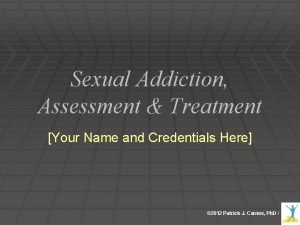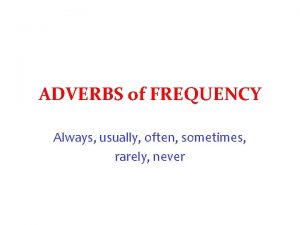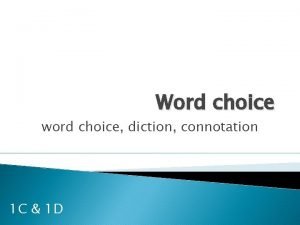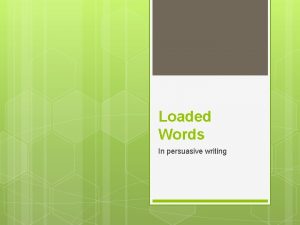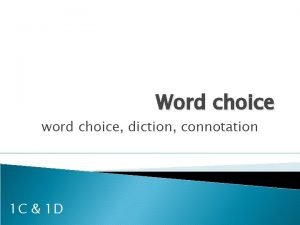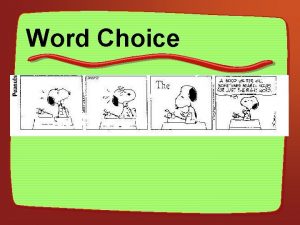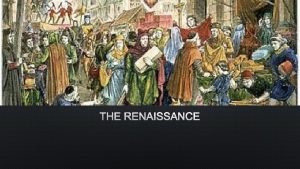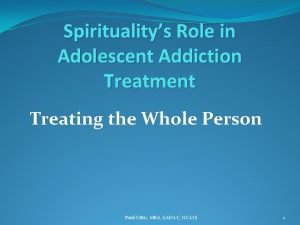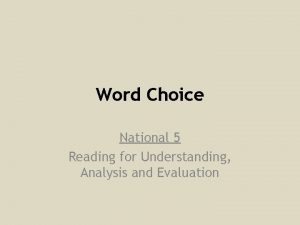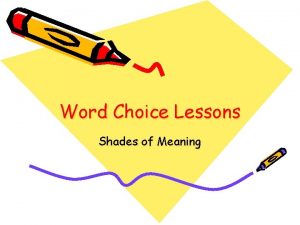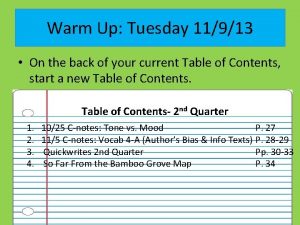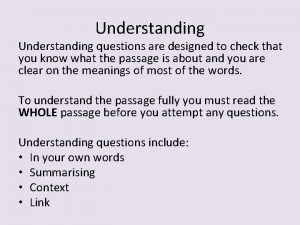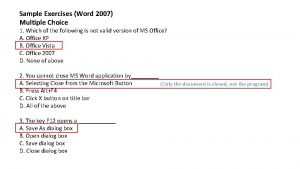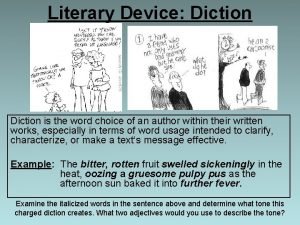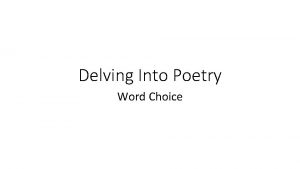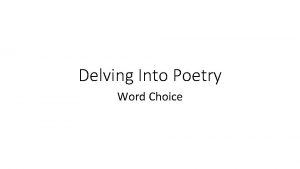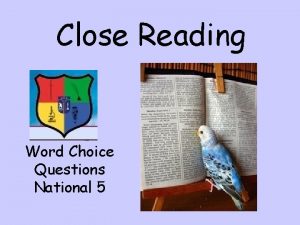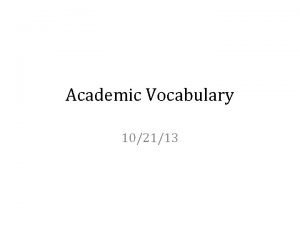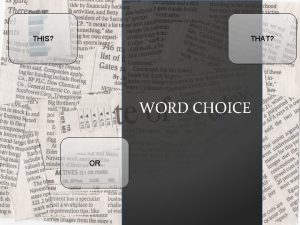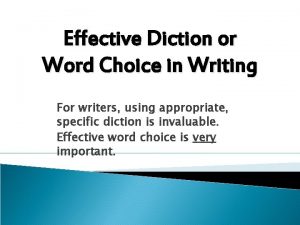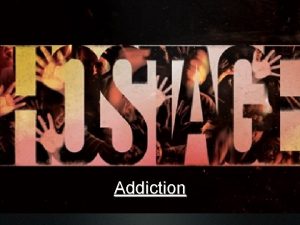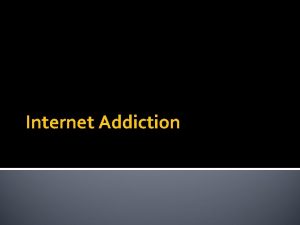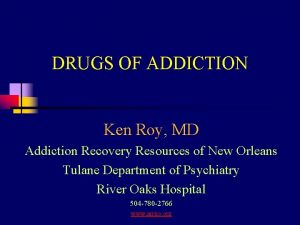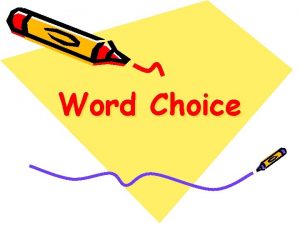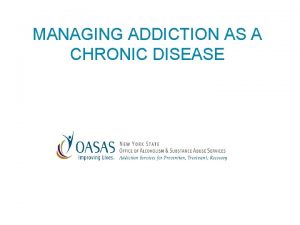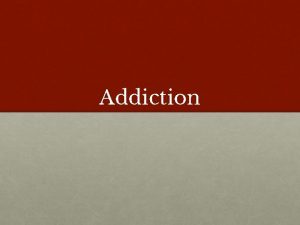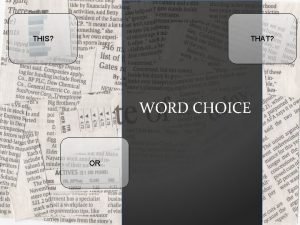Addiction and Recovery Disease Choice Word is often






















- Slides: 22

Addiction and Recovery • Disease? • Choice? • Word is often used loosely. Difference between habit and addiction? • In casual conversation – “I’m completely addicted to…. . !”

Wish we were there!

This is NOT an addiction. It’s just quirky! It: -enhances Cookie’s life -helps her stay “young” -gives her delight -is a talking point for visitors -connects with children who visit her - is intentionally in public view

Addiction has been defined as: • Any activity, substance, object, or behavior that has become the major focus of a person's life to the exclusion of other activities, or that has begun to harm the individual or others physically, mentally, or socially is considered an addictive behavior. • "At its core, addiction isn't just a social problem or a moral problem or a criminal problem. It's a brain problem whose behaviors manifest in all these other areas. Many behaviors driven by addiction are real problems and sometimes criminal acts. But the disease is about brains, not drugs. It's about underlying neurology, not outward actions. “ (Dr. Michael Miller, former president of the American Society of Addiction Medicine – ASAM) • Usually not public, done behind closed doors, covert.

Types • Substance addiction is dependence on any one or more of the following: • nicotine, or tobacco • alcohol • inhalants, often household items like oven cleaners, spray paints, or other aerosol products • drugs, illicit or non-illicit • medication • Behavioral addictions can be as serious as substance addictions. Both types result in dependency and have the same or similar negative consequences. Behavioral addiction can include: • gambling • working? • sex • Shopping? • video games? • using the Internet or media?

Opioids (Epidemic? ) • According to the American Society of Addiction Medication, opioids are defined as “a class of drugs that include the illicit drug heroin as well as the licit prescription pain relievers oxycodone, hydrocodone, codeine, morphine, fentanyl and others. ” • Have veterans, struggling through the deep valleys of physical and emotional pain, been overly medicated? • “I have to stop at the pharmacy to get my meds. ” • The power of the pharmaceutical companies. • Lots being written about overprescribing, leading to increased dependency and addiction, contributing to accidental death and suicide.

General public – our problem is that we think it’s “their problem” Seeing the addiction as an individual issue, a weakness, a fault. “Not my/our problem” Not seeing it as a systemic concern. Not seeing it as a social/community/national issue Accusatory - Volunteer vs. victim What happened to them? There but for the grace of God go I (rather than there but for different circumstances go I).

Words/Labels – “sticks and stones”words do hurt Addict Junkie Weak Deviant Out of Control Abuser User “She wants it” Dirty Sick Not right Off the Grid Unstable Useless Ugly

A few culprits -Feeling unwanted, not good enough, unworthy. -Not part of something. -Disconnected. -Unable to feel support through transitions, re-entry. -Nobody gives a damn. -Betrayed. Not heard. Feeling overburdened, with no help in sight. -Unable to speak; keeping secrets. -Moral Injury – cannot discern what’s up, down – good, bad – clear, not clear – can’t take it, got to escape, numb.

Chaos, fusion, high anxiety Jackson Pollock, Autumn Rhythm (Number 30) 1950

We all know “Steve” – 65 yr. old Vietnam Veteran; 100% SC primarily for PTSD He said: “Addiction is avoiding emotions – covering them up. Cover-up of natural feelings we don’t want to face. ” (Addiction – “way of God getting my attention”) “We deny we have a problem – we’re embarrassed. Hiding. Always hiding, ashamed, lonely. ” He admits addiction to sex, to illicit drugs, prescribed drugs. He has “given my life over to Jesus” – is often lethargic and hard to understand because of meds; managing best he can. His recovery is on-going, up and down for decades, and has included and continues to include: Many years in VA – Behavioral Health groups, in-patient stays for detox, support from veterans, lots of history with medication which continues to be tweaked, currently plays music in the chapel once a week – “it’s my therapy” – little by little realizing what has been lost, and what is to be gained if he can maintain his sobriety.

Specific for Women Veterans (though also true, in some cases, for men) -Sexual Trauma -Domestic Abuse -Keeping silent -Feeling unmoored, cracked, broken -Loose -Seen as a “volunteer, ” not a victim

Carmen – 45 yr. old Persian Gulf Veteran; 60% SC for physical issues, not for PTSD History of MST, PTSD, alcohol use, domestic abuse, chronic anxiety, deep and complicated grief due to recent loss of family members, homelessness. Makes her way to the ER when necessary, detoxes on in-house unit (usually from increased alcohol intake), has participated in multiple VA residential programs. When she is on an “upswing” she presents at chaplain offices dressed to the nines, proud of her achievements (one foot forward…), feeling hopeful, employed, in “a good place. ” Her recovery is in fits and starts, truly a roller-coaster ride, however very much assisted by, and finds joy in, her time in residential/domiciliary programs, to which she often returns.

Tamp it down • Cindy Sherman, Untitled #87; 1981

Cracked, but with a window – Carmen believes in, and keeps looking for, a hopeful future. Paul Cezanne; 1892 -94 The House with Cracked Walls

Helen – 56 yr. old Post-Vietnam Veteran; 90% SC primarily for PTSD Grieving loss of father, sick Mom, depressed, in pain, disappointed, her doctor “encouraged me to get the surgery on my breasts, which did not heal. ” Number of surgeries to address leakage and other issues – meds given freely. Home life and marriage up and down. Chart specifies: Specific Problem you'd like the pharmacist to address? Aberrant behavior, high dose opioids, need to taper. Again, Service you are asking the Pharm. D. to provide? : Opioid taper. Chaplain’s note: Vet said, "I had psych. treatment but I discontinued because I was frustrated and life at home was so bad. At one point I felt suicidal but I have friends, and the chaplain, who prayed and supported me and my faith in God. " Recovery – “Alternative” treatments including acupuncture, tapering down of meds, attends supportive groups in Behavioral Health, taking pride in her appearance, works on it, church community vital. Slow going – always in recovery and she’s well aware of it.

fractured, still beautiful Fragment of a Queen’s Face (Egypt: 1353 -1336 BCE)

Some of the latest discussions about addiction shine a light on social disconnection. Chemical “hooks” that lead to addiction may be part of the story of addiction, but certainly not the entire story. Loneliness, isolation, lack of social support, no safe place to “unload, ” feel a need to run from feelings – double whammy, nobody to talk to or care. Leads to leaning on a history and a well trodden pattern – in some people (many women) - of “holding it in, ” not sharing with others, and others not understanding the need for on-going consistent connection.

Experiments/theories RATS VIETNAM Rats left to themselves will choose water laced with cocaine – keep coming back, become “users, ” until they kill themselves. • 1 st phase - 1970’s Professor Bruce Alexander, Vancouver, created a home-like cage and put plenty of “friends” in with the lone rat – they were still curious what was in the bottle, but most disregarded the laced water. None died. • 2 nd phase – After 50+ days, those in isolation were brought out, did have withdrawal but soon stopped their heavy use. • 20% of US soldiers became addicted to heroin. Fear that they would come home and continue their habit. 95% stopped. • Professor Alexander says “addiction is an adaptation. It’s not you. It’s your cage. ” • Soldiers, he said, shifted – some not easily at all, of course – but, still, did shift, from a terrifying cage to a pleasant one.

Helping addicts reconnect with the world Portugal • Portugal had one of the worst drug problems in Europe – 1% of population addicted to heroin. • War on drugs didn’t help. They decriminalized drugs – chose to spend the money used to deal with addicts (arrests, incarceration, etc. ) on reconnecting them. Social groups – help with employment – followed. Lots of programs, etc. Drug use down by 50%. • Sound familiar? We know this!

Recovery -Never stops. -Always vigilant, always “in recovery. ” -Best chance of abstinence is if one is connected to others. -Part of the fabric of a person, a family, a nation. Many ways: 12 step programs – social networks, religious communities. BONDING. Spiritual Care. Active Listening. Frank talk about families, friends. Chaplains have a unique place in this journey.

“For 100 years now we’ve been singing war songs about addicts. I think all along we should have been singing love songs to them. Because the opposite of addiction is not sobriety; the opposite of addiction is connection. ” (Johann Hari; English writer and journalist) Valentin de Boulogne Lute Player; 1625 -26
 Sex addiction assessment
Sex addiction assessment Bharathi viswanathan
Bharathi viswanathan Always usually often sometimes
Always usually often sometimes Good choice or bad choice
Good choice or bad choice Technical diction
Technical diction Loaded language persuasive techniques examples
Loaded language persuasive techniques examples Emphatic diction
Emphatic diction Word choice in a cartoon
Word choice in a cartoon Is a french word which means rebirth
Is a french word which means rebirth Spirituality and addiction
Spirituality and addiction Word choice questions national 5
Word choice questions national 5 Word choice lessons
Word choice lessons Word choice examples
Word choice examples Ecolobby
Ecolobby How to create multiple choice questions in word 2007
How to create multiple choice questions in word 2007 Persuaive words
Persuaive words Diction definition literary device
Diction definition literary device It is the poets choice of words
It is the poets choice of words Word choice poem
Word choice poem Word choice questions examples
Word choice questions examples What is a narrative hook
What is a narrative hook Word choice matters
Word choice matters Word choice/diction
Word choice/diction
